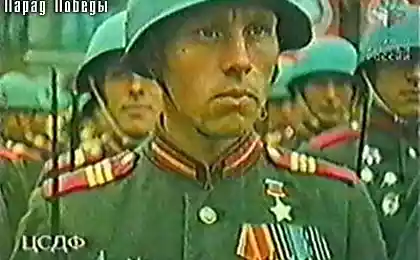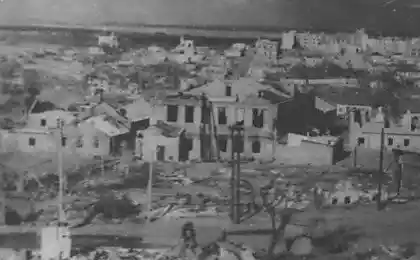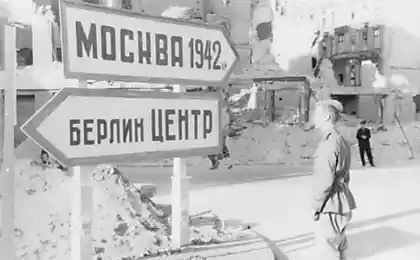1573
65th anniversary of Great Victory
55 + letter
izobrozheny
Please do not break ... I'll tell you when all
I-16 nickname donkey ishachok - Soviet single-engine piston fighter monoplane 30s, created in OKB
Polikarpov.
The first flight of a prototype was made by Valery Chkalov (State test pilot aircraft factory number 39) - December 30, 1933.
He participated in the Spanish Civil War of 1936 in the Soviet-Japanese conflict at Khalkhin Gol, in the Soviet-Finnish War, the beginning of World War II fighter aircraft fleet was the basis of the USSR. Many Soviet-aces pilots began their service on I-16.

Yak-3 - Soviet single-engine fighter aircraft of World War II. KB has been developed under the control of
Alexander Sergeyevich Yakovlev. It was a continuation of the Yak-1. Is produced from 1944 to 1945, only 4848 were built
aircraft. Recognized as the best fighter to low altitudes in the Second World War, the end of voyne.Po French pilots
Regiment Normandie-Niemen 41 Yak-3, donated, flew to France. These aircraft were armed
France until 1956.
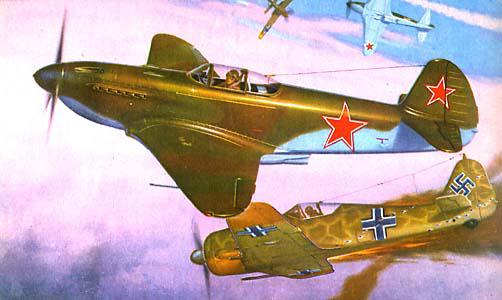
Yak-7 UTI-26 - Soviet single-engine aircraft of World War II. KB was developed by Alexander
Sergeyevich Yakovlev as a training aircraft, similar to the Yak-1. Produced since 1942, all were built
6399 aircraft.
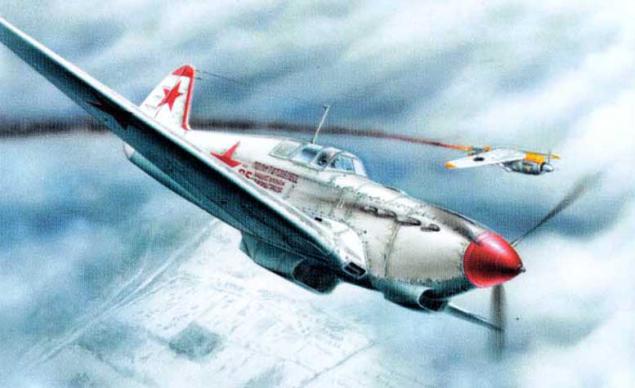
Yak-9 is the most popular Soviet fighter of World War II. It is produced from October 1942 to December
1948 years, only 16,769 were built samolёtov.Yak-9 was the logical continuation of Yak-1 and Yak-7. With
constructive point of view it was a further development of the Yak-7. Not unlike it in appearance, Yak-9
at the same time it was in all respects more perfect. This is natural, since the creation of the aircraft was considered
nearly two-year experience in the production and combat use Yak-1.prinimal part in all the operations of the Soviet Army, beginning
from the Battle of Stalingrad.

Pe-2 (foot) - Soviet dive bomber of World War II. The most massive bomber
production of the USSR. Pe-2 was actively used in front-line units, as well as in parts of the naval aviation from the early days of the Great
Patriotic War and to the end, and also took part in the battles with the Japanese army in the summer of 1945.

Pe-3 - Soviet twin-engine heavy fighter of all-metal construction. Developed in OKB-29-based dive
bomber Pe-2 under the direction of M. Petlyakov. The first flight in August 1941. From bomber
characterized by the absence of the lower hatch rifle installation and brake grids.

MiG-3 - Soviet high altitude fighter during the Second World voyny.V WWII MiG-3 was used
in various embodiments. His main qualities - high ceilings (12 thous. M) and the speed at altitudes of more than 5 thousand. M allowed
our pilots to successfully conduct combat with the enemy bombers and scouts.

LaGG-3 - Single piston single-engine monoplane fighter, the Air Force stood before the Red Army during the Great
World War II. It was used as a fighter, interceptor, fighter-bomber,
spy plane, produced in 1941-1944. One of the three new-generation fighter aircraft, taken into service before
the war (The other two - the MiG-3 and Yak-1).
The name stands for the last names of designers Lavochkin, Gorbunov, Gudkov.
Positive qualities: powerful weapons in the first series, long life, minimum use of scarce
materials - the basic material of pine and plywood impregnated with resin - delta-wood availability of manufacturing technology.

Lavochkin La-5 - single-engine monoplane fighter. Single, with enclosed cockpit, wooden frame with a cloth
paneling and wooden spars kryla.Pervye serial planes began to go off the assembly line in July 1942.
Initially, La-5 was armed with two automatic 20 mm gun ShVAK, which are placed in front of the fuselage
over the engine. Instrumentation was very meager. The aircraft did not even have a single gyroscopic device,
such as the artificial horizon or gyro. If you compare La-5, with the same aircraft in Germany, the UK or
The United States, it may seem that technically it is much inferior to them. However, his qualities, he is quite lёtnym
It meets the requirements of the time. Besides its simple design, no need for complex maintenance
and has low take-off field - making it ideal for the conditions in which the parts had to act
Soviet Air Force. Over 1942 it was produced 1129 La-5 fighters.
La-5FN
Letters FN in the marking of the aircraft represent Forced direct injection topliva.Dvigatel AL-82FN could develop
capacity of 1850 hp forced mode and maintain for 10 minutes. In April 1943, a series of Lyubertsy
air battles between the pre-production of La-5FN and captured Bf.109G-2. Training battle revealed overwhelming
Soviet fighter speed at low and medium altitudes - the main elevations of the air war on the Eastern Front. La
5FN excelled Bf.109G-2 and maneuverability on verticals.
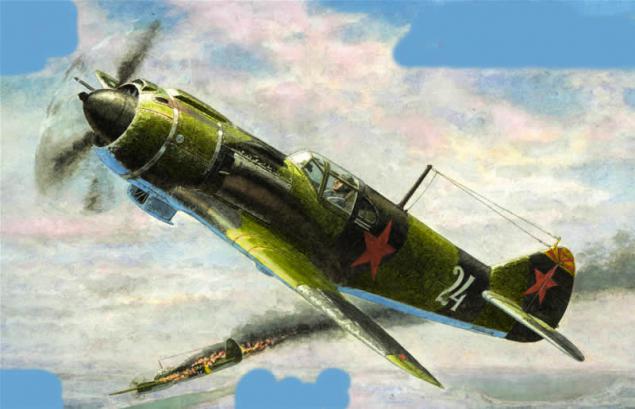
Lavochkin La-7 - a Soviet single-engine single-seat fighter monoplane. La-7 is a further development of the aircraft La 5FN.V January 1944 was released the first prototype of La-7. February 2, he flew on February 16, he entered the state tests. In May 1944, the new fighter was launched in a series under the name La-7 and in November full
drove off the assembly line La 5FN.Vse pilots are heroes of the Soviet Union, among other airplanes fought on La-7. One
of the most famous Soviet aces is a three-time Hero of the Soviet Union Ivan Kozhedub.

U-2 (PO 2) - a multipurpose biplane, created under the guidance of Polikarpov in 1928 godu.U-2 was developed for
initial training of pilots and had good piloting kachestvami.S the beginning of the Great Patriotic War
the available options at your fingertips standard U-2 began to alter in the light load night bombardirovschiki.Bombovaya
varied from 100 kg to 350 kg.
In 1943, the number of regiments equipped with the U-2, peaked - at the front in effect until 70 regiments night
bombers and scouts.
After the death of Polikarpov in 1944 the aircraft after its creator renamed Po-2. U-2 was built to standard
1953, 33,000 cars were built.
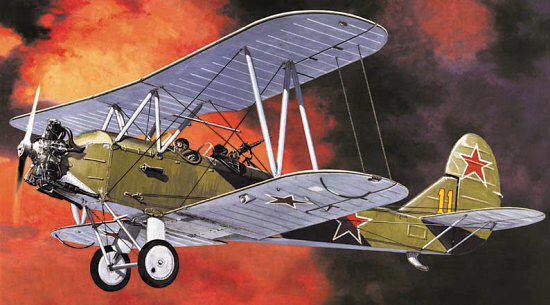
TU-2, also known as the ANT-58 and Tu-103 2 - twin-engine Soviet high speed daylight bomber (day
High-speed bomber / bomber) during the Second World War. It was built in 2257 airplanes
TU-2. Tu-2 remained in service until 1950. Some Chinese Tu-2 was shot down by British and American planes in
the Korean War. Also, it has been used in China battles with Chiang Kai-shek. Tu-2 was used limited the Air Force during the DDA
Vietnam War as a stormtrooper - for this purpose several airplanes were equipped with makeshift system created
rocket launchers, which consisted of several dozen Soviet submachine guns PCA, which is mounted in place
internal bomb bay. During a dive to the object navigator opened sash bomb hatch and brought the system
multiple rocket launchers in action.

DB-3F / IL-4 twin-engine long-range bomber. The development of DB-3 with a new cabin mate, a new fuselage (under a different production technology developed for the DC-3 / Li-2), with a new wing spar and pneumatically controlled retraction. Name of the IL-4 aircraft was in March 1942. However, DB-3 were produced about 6800 copies (including
IL-4 - 5256). The most prominent achievement of these aircraft have been bombing of Berlin at the beginning of the Great Patriotic
War.
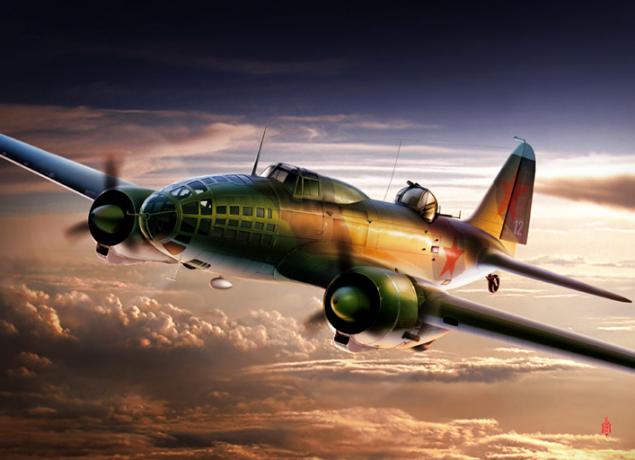
EP-2 (DB-240) - long-range bomber, a twin-engine monoplane with a wing of the "inverted gull." The aircraft is designed to
OKB-240 under the leadership of V. Ermolaeva. The bomber was the development of passenger aircraft "Steel-7»,
constructed in the Institute of CAF aircraft designer Robert Bartini Experienced DB-240 first flew on May 14, 1940.
Serial production started in October 1940. EF-2 was produced in factories in Voronezh number 18 and number 125 (39) in Irkutsk.
Production was interrupted in September 1941 and reopened in 1944. There were built 462 copies.
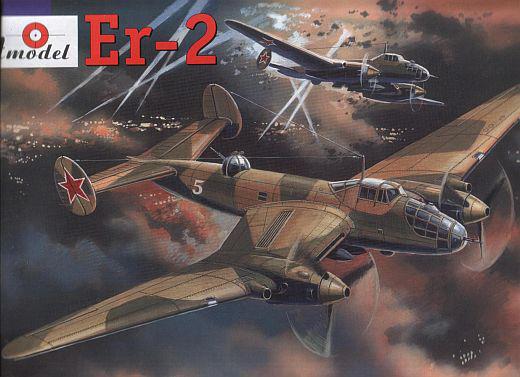
Tupolev TB-3 (also known as the ANT-6) - a heavy bomber used by the Soviet Air Force in the 1930s and during World War II. TB-3 was used during the fighting on Khalkhin Gol as a night bomber. There were carried out more than 500 sorties. It was used as well as a military transport plane. Approximately in 1938 was carried out the day span over the Japanese islands during which were dropped propaganda leaflets. TB and used
during the Russo-Finnish War. While the aircraft was officially withdrawn from service in 1939, during the Great Patriotic War June 22, 1941 the Soviet Air Force possessed 516 aircraft ready, except for 25 who were subordinate to the Navy. June 23 TB-3 began the night bombing of enemy territory. Shortage of combat-ready planes forced to use the TB-3 in the daytime unaccompanied fighter, because of what the bombers used in the majority at low altitudes, suffered greatly from enemy fighters and ground fire calculations. At the same time, the use of TB-3 night was far more successful and widespread. By August 1941 the TB-3 was 25% of all Air Force bombing and operated by experienced pilots, bomber could make up to three combat missions per night. The aircraft participated in all major battles of 1941 -1943 years, including the Battle of Smolensk, the Battle of Moscow, the Battle of Stalingrad, break the siege of Leningrad and Kursk bitvu.K July 1, 1945 the 18th Air Division still had ten TB-3 aircraft, which are in Battle
readiness.
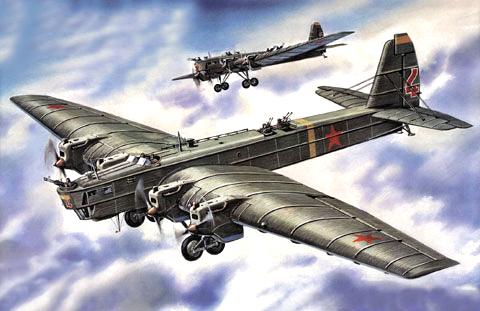
Pe-8 (other signs of TB-7 and ANT-42) - Soviet four-engine long-range heavy bomber (sometimes classified as strategic) during World War II. Throughout World War II Pe-8 is the only modern bomber of its class available to the Soviet Air Force. Used mainly for strategic bombing the enemy's rear (in particular, Pe-8 was bombed Berlin, Konigsberg, Danzig, Helsinki). During the Great Patriotic War TB-7 used as a long-range night bomber. Despite the small number, the bombers very intensively used in hostilities between 1941 and 1944 carried out 1509 sorties, dropped 5371 tons of bombs, 51 264 leaflets. Thus, the first attack on Berlin by planes Pe-8 was delivered August 10, 1941, and on April 29 1943 at Königsberg was first dropped 5,000-pound bombs. Thus TB-7 for the first time, earlier than in the United States and Britain, were raised 5-ton bombs. Pe-8 used in the strategic bombing to force Finland out of the war in 1944. In a number of cases of TB-7 used for strikes against targets in the front line, in particular, Pe-8 extensively used in the Battle of Kursk. Pe-8 and only once were used for the daily bombardment, but in spite of the successful performance of combat missions, both cars received a number of combat damage that this practice abandoned. Combat application Pe-8 was discontinued in late 1944, resulting in massive problems with the strength of the airframe. Serial production was discontinued in 1945, instead of it entered service with the Soviet Union Tu-4.
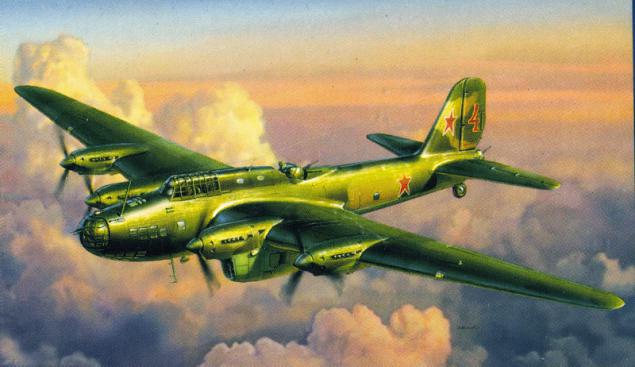
SB (ANT-40) - a high-speed bomber. The most mass production aircraft design Tupolev Design Bureau. October 7, 1934 test pilot Konstantin Popov raises in the first flight of ANT? 40. Head Serial aircraft SB was released in the spring of 1936. Over the years, construction serial SB repeatedly modernized. Just prior to the termination of serial production in 1941 was released 6831 aircraft of various modifications

IL-2 - Soviet attack aircraft of the Great Patriotic War, the Red Army design Ilyushina.V plane was nicknamed "humpback" (with the characteristic shape of the fuselage). Designers call them developed aircraft "flying tank". German pilots for its ability to endure damage called him there. «Betonflugzeug» - «a concrete aircraft" and it. «Zementbomber» - «cemented bomber." At the ground troops of the Wehrmacht aircraft enjoyed a bad reputation and has earned several unflattering nicknames such as "the butcher" (it. Schlachter), «chopper» (Fleischwolf), «Iron Gustav» (Eiserner Gustav), some Wehrmacht soldiers called him the "black death" (It. Schwarzer Tod). The most mass plane of the 1940s. He participated in the battles in all theaters of World War II and the war on Yaponiey.Atakuet with shaving flight at altitudes of 15-50 m, low height, high angular velocity and the terrain had to protect the aircraft from the fire anti-aircraft guns in while armor protects him from enemy small arms fire
infantry.
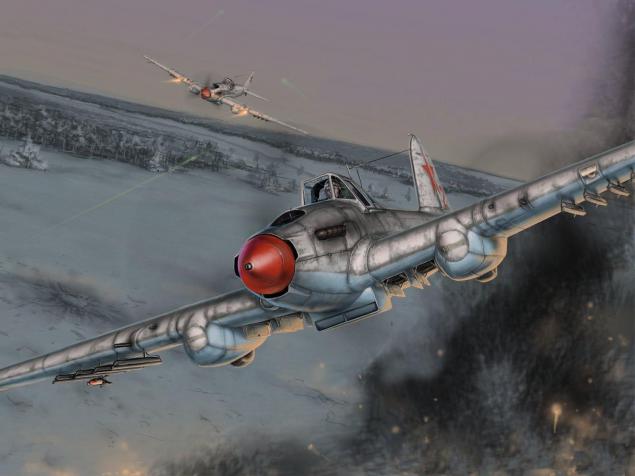
IL-10 - the final attack of the Great Patriotic War design Ilyushin Design Bureau. Created in 1944 by a deep modernization of the IL-2, the fighting began on April 16, 1945. Serial production lasted five years. Total production in 4600 fighting the IL-10 and 280 of training Wil-10.

And now our opponents
Messerschmitt Bf.109 - single-engine piston fighter nizkoplan standing on the Luftwaffe before and during World War II. It was used as a fighter, interceptor, high-altitude fighter, fighter-bomber, reconnaissance plane. By the number of produced cars (as of April 1945 - 33 984 pcs.) Is the most popular fighter aircraft in history. The share Bf.109 account for 57 percent of all aircraft manufactured by Germany-Germany istrebiteley.Bf.109 used in all theaters of war, almost all German Asa began their journey is a fighter Bf 109s

Messerschmitt Bf.110 - twin-engine heavy fighter strategic (Zerstorer) in the service of the Luftwaffe during World War II. Due to the inability to use for its intended purpose was renamed the fighter-bomber and night istrebitel.Bf 110 was first used during the German invasion of Poland in September 1939. The aircraft was widely used during the aggression against Denmark, Norway, Holland, Belgium, France, Great Britain, Greece, Yugoslavia. Bf.110 used in North Africa, supported the insurgents in Iraq in May 1941 goda.Na Soviet-German front, these planes were used little. Basically, they were used as fighter-bombers. When attacking the aerial target success accompanied them only in surprise. If sprang up maneuver fight, the fighters Bf.110 lost even older types (the case when the summer of 1941 at Taganrog on a Soviet pilot shot down I-15 just 3 Bf.110). With the emergence of a large number on the front of the Yak-1 and LaGG-3 loss Bf.110 increased significantly and the job they had to fly accompanied Bf.109. In the summer of 1943, almost all the surviving Bf.110 were withdrawn from the eastern front of the Air Command "Reich" (Germany's air defense) Since the beginning of the night raids on British air industrial facilities in Germany Bf.110D effectively used as a night fighter. Because of its range, powerful weaponry and the ability to carry a radar Bf 110 had an excellent chance to continue to fight in the night sky. The modification Bf 110 G-4 was installed radar FuG 202/220 «Lichtenstein». The operator of the radar is placed between the pilot and gunner, the team increased to three people. Night fighters often staffed by setting "slanting music».

Messerschmitt Me.163 Comet - German missile interceptor WWII.
The first flight made September 1, 1941. He produced a small series. By the end of 1944 it delivered 91 aircraft. First
sortie made May 14, 1944. These aircraft made a few missions, and it was shot down 11 machines, while they were able to kill only 9 of US-29. Because of the small amount of fuel the plane could not make a second run-up.
Me-163 had a liquid-propellant rocket engine, which was submitted to 80 percent hydrogen peroxide and the catalyst liquid (potassium permanganate solution or a mixture of methanol, hydrazine hydrate and water). In the combustion chamber, hydrogen peroxide decomposes to form large amounts of superheated steam-gas mixture, creating a powerful jet thrust.
Source:
izobrozheny
Please do not break ... I'll tell you when all
I-16 nickname donkey ishachok - Soviet single-engine piston fighter monoplane 30s, created in OKB
Polikarpov.
The first flight of a prototype was made by Valery Chkalov (State test pilot aircraft factory number 39) - December 30, 1933.
He participated in the Spanish Civil War of 1936 in the Soviet-Japanese conflict at Khalkhin Gol, in the Soviet-Finnish War, the beginning of World War II fighter aircraft fleet was the basis of the USSR. Many Soviet-aces pilots began their service on I-16.

Yak-3 - Soviet single-engine fighter aircraft of World War II. KB has been developed under the control of
Alexander Sergeyevich Yakovlev. It was a continuation of the Yak-1. Is produced from 1944 to 1945, only 4848 were built
aircraft. Recognized as the best fighter to low altitudes in the Second World War, the end of voyne.Po French pilots
Regiment Normandie-Niemen 41 Yak-3, donated, flew to France. These aircraft were armed
France until 1956.

Yak-7 UTI-26 - Soviet single-engine aircraft of World War II. KB was developed by Alexander
Sergeyevich Yakovlev as a training aircraft, similar to the Yak-1. Produced since 1942, all were built
6399 aircraft.

Yak-9 is the most popular Soviet fighter of World War II. It is produced from October 1942 to December
1948 years, only 16,769 were built samolёtov.Yak-9 was the logical continuation of Yak-1 and Yak-7. With
constructive point of view it was a further development of the Yak-7. Not unlike it in appearance, Yak-9
at the same time it was in all respects more perfect. This is natural, since the creation of the aircraft was considered
nearly two-year experience in the production and combat use Yak-1.prinimal part in all the operations of the Soviet Army, beginning
from the Battle of Stalingrad.

Pe-2 (foot) - Soviet dive bomber of World War II. The most massive bomber
production of the USSR. Pe-2 was actively used in front-line units, as well as in parts of the naval aviation from the early days of the Great
Patriotic War and to the end, and also took part in the battles with the Japanese army in the summer of 1945.

Pe-3 - Soviet twin-engine heavy fighter of all-metal construction. Developed in OKB-29-based dive
bomber Pe-2 under the direction of M. Petlyakov. The first flight in August 1941. From bomber
characterized by the absence of the lower hatch rifle installation and brake grids.

MiG-3 - Soviet high altitude fighter during the Second World voyny.V WWII MiG-3 was used
in various embodiments. His main qualities - high ceilings (12 thous. M) and the speed at altitudes of more than 5 thousand. M allowed
our pilots to successfully conduct combat with the enemy bombers and scouts.

LaGG-3 - Single piston single-engine monoplane fighter, the Air Force stood before the Red Army during the Great
World War II. It was used as a fighter, interceptor, fighter-bomber,
spy plane, produced in 1941-1944. One of the three new-generation fighter aircraft, taken into service before
the war (The other two - the MiG-3 and Yak-1).
The name stands for the last names of designers Lavochkin, Gorbunov, Gudkov.
Positive qualities: powerful weapons in the first series, long life, minimum use of scarce
materials - the basic material of pine and plywood impregnated with resin - delta-wood availability of manufacturing technology.

Lavochkin La-5 - single-engine monoplane fighter. Single, with enclosed cockpit, wooden frame with a cloth
paneling and wooden spars kryla.Pervye serial planes began to go off the assembly line in July 1942.
Initially, La-5 was armed with two automatic 20 mm gun ShVAK, which are placed in front of the fuselage
over the engine. Instrumentation was very meager. The aircraft did not even have a single gyroscopic device,
such as the artificial horizon or gyro. If you compare La-5, with the same aircraft in Germany, the UK or
The United States, it may seem that technically it is much inferior to them. However, his qualities, he is quite lёtnym
It meets the requirements of the time. Besides its simple design, no need for complex maintenance
and has low take-off field - making it ideal for the conditions in which the parts had to act
Soviet Air Force. Over 1942 it was produced 1129 La-5 fighters.
La-5FN
Letters FN in the marking of the aircraft represent Forced direct injection topliva.Dvigatel AL-82FN could develop
capacity of 1850 hp forced mode and maintain for 10 minutes. In April 1943, a series of Lyubertsy
air battles between the pre-production of La-5FN and captured Bf.109G-2. Training battle revealed overwhelming
Soviet fighter speed at low and medium altitudes - the main elevations of the air war on the Eastern Front. La
5FN excelled Bf.109G-2 and maneuverability on verticals.

Lavochkin La-7 - a Soviet single-engine single-seat fighter monoplane. La-7 is a further development of the aircraft La 5FN.V January 1944 was released the first prototype of La-7. February 2, he flew on February 16, he entered the state tests. In May 1944, the new fighter was launched in a series under the name La-7 and in November full
drove off the assembly line La 5FN.Vse pilots are heroes of the Soviet Union, among other airplanes fought on La-7. One
of the most famous Soviet aces is a three-time Hero of the Soviet Union Ivan Kozhedub.

U-2 (PO 2) - a multipurpose biplane, created under the guidance of Polikarpov in 1928 godu.U-2 was developed for
initial training of pilots and had good piloting kachestvami.S the beginning of the Great Patriotic War
the available options at your fingertips standard U-2 began to alter in the light load night bombardirovschiki.Bombovaya
varied from 100 kg to 350 kg.
In 1943, the number of regiments equipped with the U-2, peaked - at the front in effect until 70 regiments night
bombers and scouts.
After the death of Polikarpov in 1944 the aircraft after its creator renamed Po-2. U-2 was built to standard
1953, 33,000 cars were built.

TU-2, also known as the ANT-58 and Tu-103 2 - twin-engine Soviet high speed daylight bomber (day
High-speed bomber / bomber) during the Second World War. It was built in 2257 airplanes
TU-2. Tu-2 remained in service until 1950. Some Chinese Tu-2 was shot down by British and American planes in
the Korean War. Also, it has been used in China battles with Chiang Kai-shek. Tu-2 was used limited the Air Force during the DDA
Vietnam War as a stormtrooper - for this purpose several airplanes were equipped with makeshift system created
rocket launchers, which consisted of several dozen Soviet submachine guns PCA, which is mounted in place
internal bomb bay. During a dive to the object navigator opened sash bomb hatch and brought the system
multiple rocket launchers in action.

DB-3F / IL-4 twin-engine long-range bomber. The development of DB-3 with a new cabin mate, a new fuselage (under a different production technology developed for the DC-3 / Li-2), with a new wing spar and pneumatically controlled retraction. Name of the IL-4 aircraft was in March 1942. However, DB-3 were produced about 6800 copies (including
IL-4 - 5256). The most prominent achievement of these aircraft have been bombing of Berlin at the beginning of the Great Patriotic
War.

EP-2 (DB-240) - long-range bomber, a twin-engine monoplane with a wing of the "inverted gull." The aircraft is designed to
OKB-240 under the leadership of V. Ermolaeva. The bomber was the development of passenger aircraft "Steel-7»,
constructed in the Institute of CAF aircraft designer Robert Bartini Experienced DB-240 first flew on May 14, 1940.
Serial production started in October 1940. EF-2 was produced in factories in Voronezh number 18 and number 125 (39) in Irkutsk.
Production was interrupted in September 1941 and reopened in 1944. There were built 462 copies.

Tupolev TB-3 (also known as the ANT-6) - a heavy bomber used by the Soviet Air Force in the 1930s and during World War II. TB-3 was used during the fighting on Khalkhin Gol as a night bomber. There were carried out more than 500 sorties. It was used as well as a military transport plane. Approximately in 1938 was carried out the day span over the Japanese islands during which were dropped propaganda leaflets. TB and used
during the Russo-Finnish War. While the aircraft was officially withdrawn from service in 1939, during the Great Patriotic War June 22, 1941 the Soviet Air Force possessed 516 aircraft ready, except for 25 who were subordinate to the Navy. June 23 TB-3 began the night bombing of enemy territory. Shortage of combat-ready planes forced to use the TB-3 in the daytime unaccompanied fighter, because of what the bombers used in the majority at low altitudes, suffered greatly from enemy fighters and ground fire calculations. At the same time, the use of TB-3 night was far more successful and widespread. By August 1941 the TB-3 was 25% of all Air Force bombing and operated by experienced pilots, bomber could make up to three combat missions per night. The aircraft participated in all major battles of 1941 -1943 years, including the Battle of Smolensk, the Battle of Moscow, the Battle of Stalingrad, break the siege of Leningrad and Kursk bitvu.K July 1, 1945 the 18th Air Division still had ten TB-3 aircraft, which are in Battle
readiness.

Pe-8 (other signs of TB-7 and ANT-42) - Soviet four-engine long-range heavy bomber (sometimes classified as strategic) during World War II. Throughout World War II Pe-8 is the only modern bomber of its class available to the Soviet Air Force. Used mainly for strategic bombing the enemy's rear (in particular, Pe-8 was bombed Berlin, Konigsberg, Danzig, Helsinki). During the Great Patriotic War TB-7 used as a long-range night bomber. Despite the small number, the bombers very intensively used in hostilities between 1941 and 1944 carried out 1509 sorties, dropped 5371 tons of bombs, 51 264 leaflets. Thus, the first attack on Berlin by planes Pe-8 was delivered August 10, 1941, and on April 29 1943 at Königsberg was first dropped 5,000-pound bombs. Thus TB-7 for the first time, earlier than in the United States and Britain, were raised 5-ton bombs. Pe-8 used in the strategic bombing to force Finland out of the war in 1944. In a number of cases of TB-7 used for strikes against targets in the front line, in particular, Pe-8 extensively used in the Battle of Kursk. Pe-8 and only once were used for the daily bombardment, but in spite of the successful performance of combat missions, both cars received a number of combat damage that this practice abandoned. Combat application Pe-8 was discontinued in late 1944, resulting in massive problems with the strength of the airframe. Serial production was discontinued in 1945, instead of it entered service with the Soviet Union Tu-4.

SB (ANT-40) - a high-speed bomber. The most mass production aircraft design Tupolev Design Bureau. October 7, 1934 test pilot Konstantin Popov raises in the first flight of ANT? 40. Head Serial aircraft SB was released in the spring of 1936. Over the years, construction serial SB repeatedly modernized. Just prior to the termination of serial production in 1941 was released 6831 aircraft of various modifications

IL-2 - Soviet attack aircraft of the Great Patriotic War, the Red Army design Ilyushina.V plane was nicknamed "humpback" (with the characteristic shape of the fuselage). Designers call them developed aircraft "flying tank". German pilots for its ability to endure damage called him there. «Betonflugzeug» - «a concrete aircraft" and it. «Zementbomber» - «cemented bomber." At the ground troops of the Wehrmacht aircraft enjoyed a bad reputation and has earned several unflattering nicknames such as "the butcher" (it. Schlachter), «chopper» (Fleischwolf), «Iron Gustav» (Eiserner Gustav), some Wehrmacht soldiers called him the "black death" (It. Schwarzer Tod). The most mass plane of the 1940s. He participated in the battles in all theaters of World War II and the war on Yaponiey.Atakuet with shaving flight at altitudes of 15-50 m, low height, high angular velocity and the terrain had to protect the aircraft from the fire anti-aircraft guns in while armor protects him from enemy small arms fire
infantry.

IL-10 - the final attack of the Great Patriotic War design Ilyushin Design Bureau. Created in 1944 by a deep modernization of the IL-2, the fighting began on April 16, 1945. Serial production lasted five years. Total production in 4600 fighting the IL-10 and 280 of training Wil-10.

And now our opponents
Messerschmitt Bf.109 - single-engine piston fighter nizkoplan standing on the Luftwaffe before and during World War II. It was used as a fighter, interceptor, high-altitude fighter, fighter-bomber, reconnaissance plane. By the number of produced cars (as of April 1945 - 33 984 pcs.) Is the most popular fighter aircraft in history. The share Bf.109 account for 57 percent of all aircraft manufactured by Germany-Germany istrebiteley.Bf.109 used in all theaters of war, almost all German Asa began their journey is a fighter Bf 109s

Messerschmitt Bf.110 - twin-engine heavy fighter strategic (Zerstorer) in the service of the Luftwaffe during World War II. Due to the inability to use for its intended purpose was renamed the fighter-bomber and night istrebitel.Bf 110 was first used during the German invasion of Poland in September 1939. The aircraft was widely used during the aggression against Denmark, Norway, Holland, Belgium, France, Great Britain, Greece, Yugoslavia. Bf.110 used in North Africa, supported the insurgents in Iraq in May 1941 goda.Na Soviet-German front, these planes were used little. Basically, they were used as fighter-bombers. When attacking the aerial target success accompanied them only in surprise. If sprang up maneuver fight, the fighters Bf.110 lost even older types (the case when the summer of 1941 at Taganrog on a Soviet pilot shot down I-15 just 3 Bf.110). With the emergence of a large number on the front of the Yak-1 and LaGG-3 loss Bf.110 increased significantly and the job they had to fly accompanied Bf.109. In the summer of 1943, almost all the surviving Bf.110 were withdrawn from the eastern front of the Air Command "Reich" (Germany's air defense) Since the beginning of the night raids on British air industrial facilities in Germany Bf.110D effectively used as a night fighter. Because of its range, powerful weaponry and the ability to carry a radar Bf 110 had an excellent chance to continue to fight in the night sky. The modification Bf 110 G-4 was installed radar FuG 202/220 «Lichtenstein». The operator of the radar is placed between the pilot and gunner, the team increased to three people. Night fighters often staffed by setting "slanting music».

Messerschmitt Me.163 Comet - German missile interceptor WWII.
The first flight made September 1, 1941. He produced a small series. By the end of 1944 it delivered 91 aircraft. First
sortie made May 14, 1944. These aircraft made a few missions, and it was shot down 11 machines, while they were able to kill only 9 of US-29. Because of the small amount of fuel the plane could not make a second run-up.
Me-163 had a liquid-propellant rocket engine, which was submitted to 80 percent hydrogen peroxide and the catalyst liquid (potassium permanganate solution or a mixture of methanol, hydrazine hydrate and water). In the combustion chamber, hydrogen peroxide decomposes to form large amounts of superheated steam-gas mixture, creating a powerful jet thrust.
Source:





